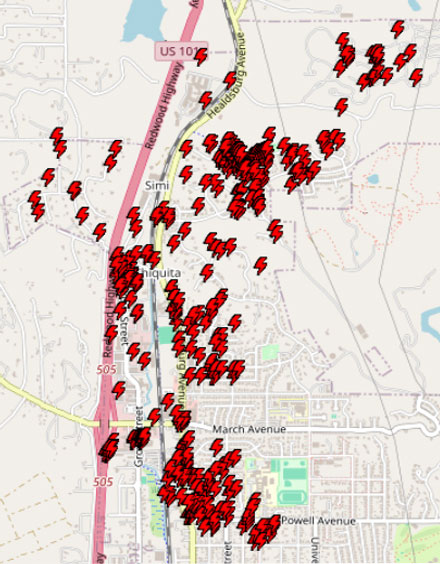
It seemed like adding insult to injury, opening a city utilities bill last month to find the bill had almost doubled, then finding oneself without power for several hours on Sunday morning.
The latter event took place on Oct. 6, beginning at approximately 7:16am and ending at 8:42am. “The outage on Sunday morning was caused by a squirrel contacting Healdsburg’s high-voltage power lines,” said Terry Crowley, the city’s utilities director. “Roughly 1,435 customers were impacted by the 86-minute power outage.”
A map posted on social media showed a swarm of affected properties along Powell and Healdsburg avenues, and many homes along Grove Street up Healdsburg Avenue to Parkland Farms. The incident was evidently caused by a squirrel climbing a pole at the corner of Monte Vista and Healdsburg avenues. Crowley said the city’s feed for the north part of town runs down Powell Avenue and then up Healdsburg Avenue to the city’s northern border.

“It has been hypothesized that the threat to the internet, infrastructure and services posed by squirrels may exceed that posed by cyberattacks,” according to a cybersecurity expert cited in a Wikipedia report, and a New York Times opinion columnist last year admitted his obsession with squirrel-caused power outages—such as that which shut down NASDAQ in 1987, and again in 1994.
But the city didn’t just throw the breaker and get back to business as usual. Instead, according to Crowley, it took the opportunity to perform a “thorough inspection of overhead power lines before restoring power.”
Persistent high daily temperatures and the lower relative humidity of summer made this a good time to perform that inspection, said Crowley, which helped “reduce the risk of utility-caused fires but can delay turning the power back on.”
The squirrel did not survive the encounter with the city’s high-voltage power lines. No photos were released, according to Crowley. “We generally don’t share those as they may be upsetting for some individuals,” he said.
Rate Increases
Although as Crowley said, “The outage was not related to higher energy prices,” the coincidence of the Sunday morning blackout brought to mind the recent city utilities hike. Outraged threads erupted on social platforms when customers’ September bills were opened, which in many cases included both higher electrical costs from the hot summer weather and a new water rate schedule adopted in July.
In fact, the city had made extensive efforts to communicate with its residents on the reasons for, timing of and roll-out of the increased rates, and the water- and sewer-rate discussion covered in this newspaper. But many rate-payers were seemingly blindsided by the increases.
Electric rates were increased in November 2023, and a new city water rate schedule was approved in May of this year. Projections were for electric bills higher by about $10 for most customers, and about a $25 monthly increase in water billing. Both figures however depend on usage, and Crowley speculated that the confluence of higher electric usage during the hot summer months and new water rates combined to spike consumers’ rates.
“For many customers, the July and August utility bills reflected an increase in both energy and water usage, with overall energy consumption up about 24% year-over-year and water usage up about 20%,” he said by email.
Thus, he added, higher rates are inevitably connected to customer usage. “For many customers, the largest driving factor of their utility bill is usage. This is underscored by the fact that the water- and sewer-rate increases did not go into effect until the August bills; however, many customers experienced increases on their July bill. For some larger residential users, the tiered rates resulted in a larger increase in their respective monthly water costs on the August bills. The increased usage combined with the planned rate increases both contributed to higher water bills,” he said.
Furthermore, the “overall usage has been higher than predictions and resulted in higher bills,” with the “sustained high heat experienced in July and August likely playing a large role in increased consumption,” Crowley continued.
Public Power Week
Adding another current to the theme, it was Public Power Week (Oct. 6-12), to celebrate the benefits of living in a public power community. Healdsburg is such a public power community, as opposed to a rural cooperative or an investor-owned utility, such as PG&E.
But what to do about higher utility bills? The city does have an income-qualified discount for customers through the CARE Program ci.healdsburg.ca.us/173/Utility-Programs, and a number of other conservation programs and rebates can be reviewed at Smart Living Healdsburg, healdsburg.gov/424/Smart-Living-Healdsburg.
But as the utilities director pointed out, “The best option to reducing monthly utility bills is becoming more efficient with water and energy usage. This may mean limiting air-conditioning and reducing irrigation cycles.”









Rocky, the Flying Squirrel, meets his electrifying end. Bullwinkle has arranged for a memorial service at Oak Mound Cemetery on Sunday afternoon. The moose has asked that mourners bring walnuts.